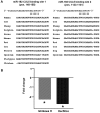Cullin-5, a ubiquitin ligase scaffold protein, is significantly underexpressed in endometrial adenocarcinomas and is a target of miR-182
- PMID: 26847831
- PMCID: PMC4774736
- DOI: 10.3892/or.2016.4605
Cullin-5, a ubiquitin ligase scaffold protein, is significantly underexpressed in endometrial adenocarcinomas and is a target of miR-182
Abstract
Altered expression of cullin-5 (CUL5), a member of the cullin-RING E3 ubiquitin ligase family, has been implicated in a number of types of cancers including breast, cervical and hepatocellular cancers. In the present study, we found that CUL5 expression was significantly decreased in both endometrioid and serous endometrial adenocarcinomas with the more aggressive serous type displaying a higher reduction (-4.3-fold) than the less aggressive endometrioid type (-2.9-fold). Overexpression of CUL5 mRNA and protein in Ishikawa H endometrial cancer cells resulted in decreased cell proliferation and in a reduction in CUL5-RING E3 ligase downstream clients JAK2 and FAS-L. Finally, we demonstrated for the first time that CUL5 is a direct target of miR-182 that we previously showed to be significantly overexpressed in endometrial adenocarcinomas and we provided evidence that increased miR-182 expression is, at least in part, a result of demethylation of its upstream promoter. These data suggest a cascade in which miR-182 expression is epigenetically increased leading to decreased CUL5 expression and increased cellular proliferation. The final step in the cascade may be operating through a decrease in ubiquitination of pro-growth CUL5 ubiquitin ligase clients. This cascade offers a series of potential interventional steps involving epigenetic modification, miRNA and/or gene targeting and ubiquitination.
Figures




Similar articles
-
The functions and properties of cullin-5, a potential therapeutic target for cancers.Am J Transl Res. 2020 Feb 15;12(2):618-632. eCollection 2020. Am J Transl Res. 2020. PMID: 32194910 Free PMC article. Review.
-
Downregulation of miR-7 upregulates Cullin 5 (CUL5) to facilitate G1/S transition in human hepatocellular carcinoma cells.IUBMB Life. 2013 Dec;65(12):1026-34. doi: 10.1002/iub.1231. Epub 2013 Dec 13. IUBMB Life. 2013. PMID: 24339204
-
microRNA expression profiling of endometrial endometrioid adenocarcinomas and serous adenocarcinomas reveals profiles containing shared, unique and differentiating groups of microRNAs.Oncol Rep. 2011 Oct;26(4):995-1002. doi: 10.3892/or.2011.1372. Epub 2011 Jul 1. Oncol Rep. 2011. PMID: 21725615 Free PMC article.
-
Mechanism and functional consequences of loss of FOXO1 expression in endometrioid endometrial cancer cells.Oncogene. 2008 Jan 3;27(1):9-19. doi: 10.1038/sj.onc.1210626. Epub 2007 Jun 25. Oncogene. 2008. PMID: 17599040
-
A proposed model for endometrial serous carcinogenesis.Am J Surg Pathol. 2011 Jan;35(1):e1-e14. doi: 10.1097/PAS.0b013e318202772e. Am J Surg Pathol. 2011. PMID: 21164282 Review.
Cited by
-
The functions and properties of cullin-5, a potential therapeutic target for cancers.Am J Transl Res. 2020 Feb 15;12(2):618-632. eCollection 2020. Am J Transl Res. 2020. PMID: 32194910 Free PMC article. Review.
-
Chromatin-Bound Cullin-Ring Ligases: Regulatory Roles in DNA Replication and Potential Targeting for Cancer Therapy.Front Mol Biosci. 2018 Mar 13;5:19. doi: 10.3389/fmolb.2018.00019. eCollection 2018. Front Mol Biosci. 2018. PMID: 29594129 Free PMC article. Review.
-
Involvement of E3 Ligases and Deubiquitinases in the Control of HIF-α Subunit Abundance.Cells. 2019 Jun 15;8(6):598. doi: 10.3390/cells8060598. Cells. 2019. PMID: 31208103 Free PMC article. Review.
-
Recent findings on epigenetic gene abnormalities involved in uterine cancer.Mol Clin Oncol. 2017 Nov;7(5):733-737. doi: 10.3892/mco.2017.1428. Epub 2017 Sep 20. Mol Clin Oncol. 2017. PMID: 29181164 Free PMC article.
-
Circular RNAs: A Promising Biomarker for Endometrial Cancer.Cancer Manag Res. 2021 Feb 17;13:1651-1665. doi: 10.2147/CMAR.S290975. eCollection 2021. Cancer Manag Res. 2021. PMID: 33633465 Free PMC article. Review.
References
Publication types
MeSH terms
Substances
Grants and funding
LinkOut - more resources
Full Text Sources
Other Literature Sources
Research Materials
Miscellaneous

